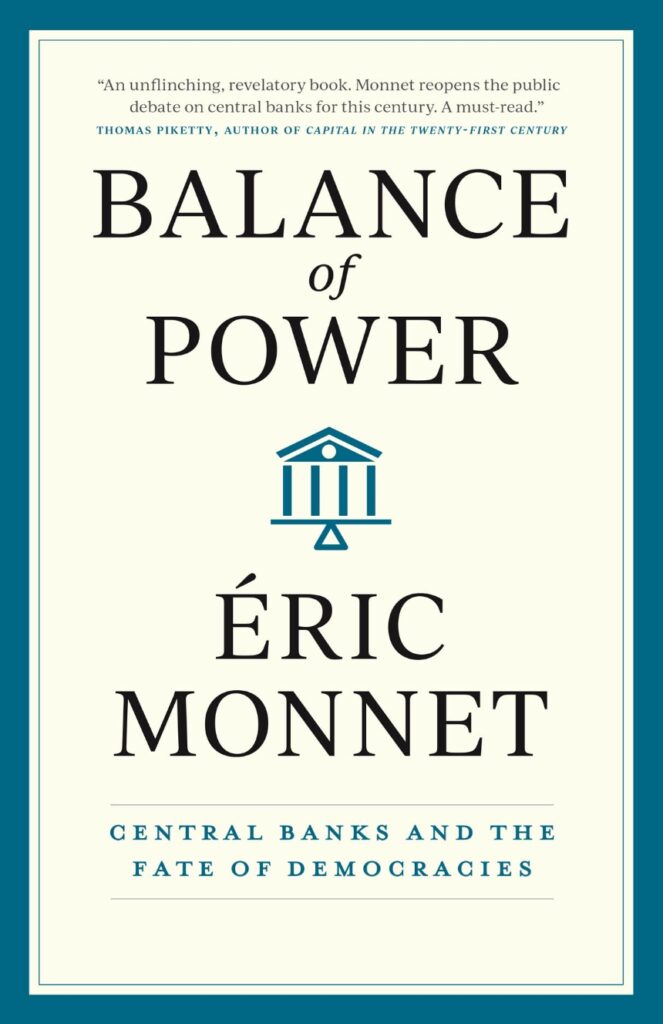Balance of Power: Central Banks and the Fate of Democracies – ProMarket
Balance of Power: Central Banks and the Fate of Democracies ProMarket


The Role of Central Banks in Democratic Societies
Introduction
The following is an excerpt from the book, Balance of Power: Central Banks and the Fate of Democracies, by Éric Monnet.
The Importance of Democratic Oversight
Central banks’ role as de facto insurance providers to financial markets and states, in principle for the benefit of the population, gives them a special place in the state apparatus and the economy. However, this should not give them undue leeway without checks and balances. As an institution serving the public good, the central bank must be subject to democratic debate and institutional balance of power—not as a purely technical manager dealing with matters isolated from the rest of economic and social policy.
The Importance of Central Bank Independence
The point is not to question the independence of central banks—that is, the principles according to which they make their decisions without instructions from the government. Indeed, such independent administrative authorities are a legitimate component of modern democracies, and they are part of the balance of powers. Democracies are a system of checks and balances, not the unlimited power of the parliamentary majority. Moreover, the autonomy of the central bank can be seen as essential for its ability to come to the aid of the state, if need be, when the government fails to do so. The history of central banks shows that such independence has always been one of their defining characteristics, albeit to differing degrees. Central banks’ very existence is justified by the fact that people believe that money is more efficiently managed by an institution that is separate from a Treasury department or ministry of finance.
Strengthening Central Bank Values
Even so, the values that justify this independence (imperatives such as reflexivity, accountability, impartiality, and transparency) require strengthening if they are to be adapted to the central banks’ current activities. Independence does not mean that there is no consultation or coordination with other policies or democratic structures; that is what has been too long forgotten.
Updating the Terms of Independence
It is possible, in other words, to accept the protective role of the central bank while also updating the terms of its independence. In fact, it is all the more necessary because—like other public administrations since the turn toward economic liberalism in the 1980s—the policy of the central banks has deviated in recent decades from the principles of the welfare state (i.e., maximizing the welfare of the public) that once characterized it. This has produced disastrous consequences for the economy, including financial instability and the proliferation of inequalities. The last decades have seen many central bankers more preoccupied with giving lectures on the liberalization of the labor market or the privatization of retirement plans than with sticking to the objectives of financial stability or targeting inflation.
The Evolution of Central Banks
The central banks, as we see them today (that is, as public institutions that are not subordinated to the goal of increasing private shareholders’ profits), were largely created after World War II. Central banks have a long history, but they were profoundly reformed in the middle of the twentieth century, at the same time as the policies that made up the welfare state and with similar objectives. (The United States is to a certain extent an exception in this regard, to which I shall return.) They are no longer controlled by private shareholders, and their money creation is no longer limited by gold reserve laws. They were quickly integrated into the state apparatus and into a set of macroeconomic policies that had not existed earlier in their history. Starting in the 1980s, the strengthening of central bank independence relative to governments reduced the range of the central banks’ activities. This has not, however, led to a questioning of the fact that they should be under parliamentary oversight, independent of private interest, and in charge of macroeconomic policy on behalf of the common good. There has been no return to the principles of central banking that prevailed before World War II. Yet the definition of central bank independence formulated at the end of the twentieth century was not well equipped to address the new economic and democratic challenges of the early twenty-first century. We are left with an unsustainable gap between what central banks actually do and the institutional framework that defines their responsibility.
The Link Between Central Banks and the Welfare State
The macroeconomic principles on which central banks and the welfare state were conceived were the same: countercyclical policies intended to protect individuals from economic risk (including price and financial instability) and reduce overall uncertainty. But these historical and conceptual links between central banks and the welfare state are rarely made explicit. Drawing attention to them does not mean to suggest that we should ask the central bank to pay for welfare benefits. The point is to recognize that, like other pillars of the welfare state in capitalist societies, the central bank performs a function of managing risks and reducing uncertainty. Just as the risks evolve, so too must the institutions. As the twentieth-century economic anthropologist Karl Polanyi said, the central bank’s policy is always a form of interventionism that evolves over time in accord with the nature of the state. It reflects the choices made regarding distribution and power in
SDGs, Targets, and Indicators
-
SDGs Addressed or Connected to the Issues Highlighted in the Article
- SDG 10: Reduced Inequalities
- SDG 16: Peace, Justice, and Strong Institutions
- SDG 17: Partnerships for the Goals
The article discusses the role of central banks in relation to economic and social policies, highlighting the need for democratic debate, institutional balance of power, and accountability. These issues are connected to SDG 10, which aims to reduce inequalities within and among countries. The article also emphasizes the importance of democratic institutions and checks and balances, aligning with SDG 16. Additionally, the mention of coordination with other policies and democratic structures relates to SDG 17, which promotes partnerships for sustainable development.
-
Specific Targets Under the Identified SDGs
- SDG 10.1: By 2030, progressively achieve and sustain income growth of the bottom 40% of the population at a rate higher than the national average.
- SDG 16.6: Develop effective, accountable, and transparent institutions at all levels.
- SDG 17.15: Respect each country’s policy space and leadership to establish and implement policies for poverty eradication and sustainable development.
The article does not explicitly mention specific targets, but the issues discussed align with these targets. The focus on reducing inequalities and promoting accountability corresponds to SDG 10.1. The emphasis on democratic institutions and balance of power relates to SDG 16.6. The call for respecting policy space and leadership connects to SDG 17.15.
-
Indicators Mentioned or Implied in the Article
- Accountability of central banks to democratic structures
- Coordination and consultation with other policies
- Democratic debate and institutional balance of power
The article implies indicators that can be used to measure progress towards the identified targets. These indicators include the accountability of central banks to democratic structures, as mentioned in the article. The need for coordination and consultation with other policies can also be seen as an indicator. Additionally, the emphasis on democratic debate and institutional balance of power suggests the importance of measuring the presence and effectiveness of these elements in central bank operations.
Table: SDGs, Targets, and Indicators
| SDGs | Targets | Indicators |
|---|---|---|
| SDG 10: Reduced Inequalities | SDG 10.1: By 2030, progressively achieve and sustain income growth of the bottom 40% of the population at a rate higher than the national average. | Accountability of central banks to democratic structures |
| SDG 16: Peace, Justice, and Strong Institutions | SDG 16.6: Develop effective, accountable, and transparent institutions at all levels. | Coordination and consultation with other policies Democratic debate and institutional balance of power |
| SDG 17: Partnerships for the Goals | SDG 17.15: Respect each country’s policy space and leadership to establish and implement policies for poverty eradication and sustainable development. | Coordination and consultation with other policies |
Behold! This splendid article springs forth from the wellspring of knowledge, shaped by a wondrous proprietary AI technology that delved into a vast ocean of data, illuminating the path towards the Sustainable Development Goals. Remember that all rights are reserved by SDG Investors LLC, empowering us to champion progress together.
Source: promarket.org

Join us, as fellow seekers of change, on a transformative journey at https://sdgtalks.ai/welcome, where you can become a member and actively contribute to shaping a brighter future.








